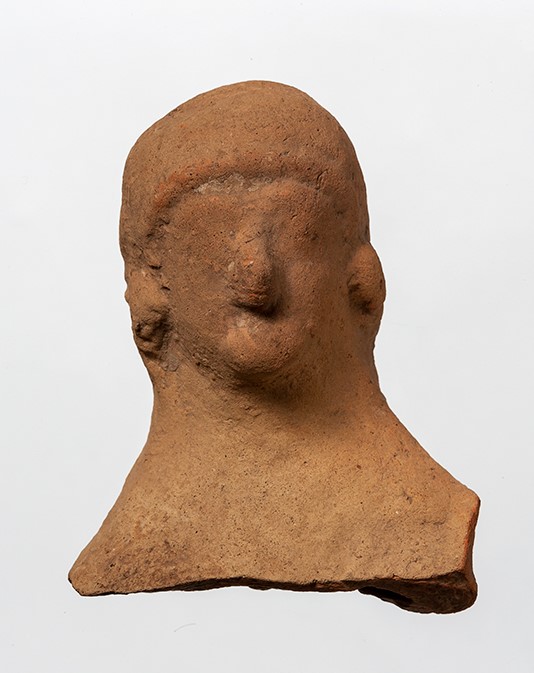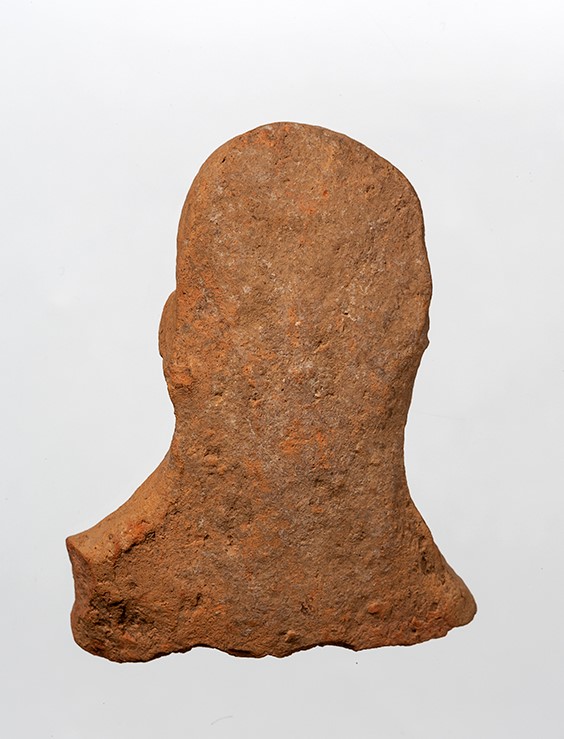Acquisition number: 1973.21
Head and shoulders of a male (?) figure. The chest and lower body are missing. Orange-buff clay with small white, black and red inclusions and some traces of mica; some small irregular voids. The figure was made from a single sheet of clay, pressed into the mould for the front and then the sides folded over and joined down the centre of the back; the join was pared smooth on the outside (but is still visible within). The front is smoothly finished although some clay accretions adhere to the surface.
Title: Fragmentary Statuette - 1973.21
Acquisition number: 1973.21
Author or editor: J.R. Green
Culture or period: Cypriot.
Date: c. 5th century BC.
Material: Clay - Terracotta
Object type: Sculpture and figurines
Dimensions: 102mm (h)
Origin region or location: Cyprus
Origin city: Achna
Display case or on loan: 3
Keywords: Cypriot, Figurine, Fragment, Achna
J.R. Green with B. Rawson, Catalogue of Antiquities in the Australian National University, A.N.U. (Canberra, 1981) 83; J.M. Webb, Cypriote Antiquities in Australian Collections, i (Corpus of Cypriote Antiquities 18, SIMA XX: 18, Jonsered 1997) 51-52 nos 213-216, pl. 16.
1973.21
Fragmentary Statuette
Preserved ht 10.2cm.
Cyril Henry Leach Bequest by courtesy of the Trustees of the British Museum; from Achna, Cyprus.
Head and shoulders of a male (?) figure. The chest and lower body are missing. Orange-buff clay with small white, black and red inclusions and some traces of mica; some small irregular voids. The figure was made from a single sheet of clay, pressed into the mould for the front and then the sides folded over and joined down the centre of the back; the join was pared smooth on the outside (but is still visible within). The front is smoothly finished although some clay accretions adhere to the surface.
The hair is done in a narrow roll above the brow and it bunches about the ears with some modelling (waviness) at right. It is smooth on the top of the head. There seem to be traces of clothing about the breast and shoulders.
The line of the left shoulder, particularly at the break, indicates that this shoulder was higher and therefore that the arm was not hanging, like the right, at the side of the body but brought across the front.
There are traces of slip on the forehead at the hairline, but no paint is preserved. The figure is probably but not certainly male. Perhaps fifth century BC.
Achna lies in south-east Cyprus, about halfway between Larnaka and Famagusta. The sanctuary there was excavated in 1882 by Ohnefalsch-Richter on behalf of Charles Newton, and a proportion of the finds went to the British Museum: M. Ohnefalsch-Richter, Kypros, the Bible and Homer (London 1893) 1-2 and Index. See also A. Caubet, “Achna, 1882: réflexion sur les découvertes du sanctuaire chypro-archaïque et classique”, in: G.C. Ioannides (ed.), Studies in Honour of Vassos Karageorghis (Kypriakai Spoudai 44-45, Nicosia 1992) 261-267.
These figurines represent fairly popular types of the sixth-fifth centuries BC. The females and doubtless the male (?) represent worshippers and would be suitable both for the grave and as votives at a sanctuary. The females of the type seen here are generally described as playing musical instruments, although the detail is rarely clear. Compare Ohnefalsch-Richter, op.cit., pl. 11, 3 and pl. 12, 1 and 3; A. Brown and H. Catling, “Additions to the Cypriot Collection in the Ashmolean Museum, Oxford”, Opuscula Atheniensia 13, 1980, 128-130 nos 100 and 102-103, also from Achna.
The sacred tree was a common motif in Cyprus on seals and vases from the Bronze Age on. In terracotta they are often found at the centre of a circle of dancers. For such terracottas, see Ohnefalsch-Richter 127-131 and pl. 76, Swedish Cyprus Expedition I, passim, and J.L. Myres, Handbook of the Cesnola Collection of Antiquities from Cyprus (New York 1914) 355. Webb gives further parallels: see J.M. Webb, Cypriote Antiquities in Australian Collections, i (Corpus of Cypriote Antiquities 18, SIMA XX: 18, Jonsered 1997).
For Cypriot terracottas more generally, see the excellent study by A. Caubet et al., L’art des modeleurs d’argile. Antiquités de Chypre. Coroplastique (Paris 1998).
J.R. Green with B. Rawson, Catalogue of Antiquities in the Australian National University, A.N.U. (Canberra, 1981) 83; J.M. Webb, Cypriote Antiquities in Australian Collections, i (Corpus of Cypriote Antiquities 18, SIMA XX: 18, Jonsered 1997) 51-52 nos 213-216, pl. 16.

